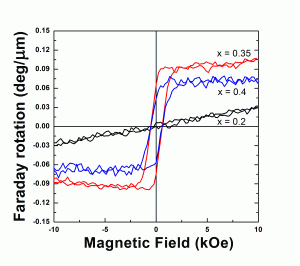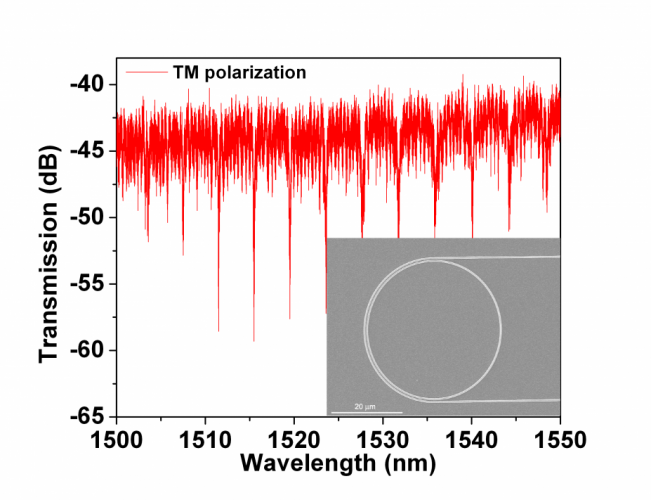Magnetic Oxides for Optical Isolators and Magnetoelectronic Devices
We maintain a thin-film laboratory that includes a pulsed-laser deposition (PLD) system and an ultra-high vacuum sputter system. In PLD, a high-energy excimer laser ablates a target, releasing a plume of material that deposits on a substrate to form a thin film. The PLD is particularly useful for making complex materials such as oxides because it preserves the stoichiometry of the target material.
We have been using PLD to deposit a variety of oxide films for magneto-optical devices such as isolators. The ideal material for an isolator combines high Faraday rotation with high optical transparency. Garnets such as bismuth iron garnet (BIG, Bi3Fe5O12), have excellent properties but do not grow well on silicon substrates, making it difficult to integrate these materials. One solution is to develop new magneto-optical active materials, which can grow epitaxially on Si by using buffer layers. After being doped with transitional metal ions, these materials can exhibit strong Faraday rotation as well as low optical loss. We have examined Fe and Co-doped SrTiO3 thin films (Figure 1) [1] [2], which show strong magneto-optical properties and lower optical absorption than iron oxide. The best figure of merit, defined as Faraday rotation divided by optical absorption loss at 1550-nm wavelength, was achieved in Sr(Ti0.6Fe0.4)O3 (1.1 deg/dB) and Sr(Ti0.7Co0.3)O3 (0.57 deg/dB). These films show strong magnetic anisotropy, which is considered to be due to magnetoelastic effects. These films could be useful for waveguide isolators and other magnetoelectronic devices in which optical absorption losses are critical. Additionally, we have built strip-loaded waveguides and ring resonators on a silicon platform using polycrystalline yttrium iron garnet (YIG) films and As2S3 or Si guiding layers. These material-independent device designs can be used in future on-chip optical isolators. For the first time, the infrared optical loss of polycrystalline YIG was characterized in waveguide and resonator geometries [3]. A second project uses PLD to grow multiferroic thin films exhibiting a strong magnetoelectric coupling due to their self-assembled nanostructure. Alternate deposition of layers of a ferromagnetic spinel (cobalt ferrite, CoFe2O4) and a ferroelectric perovskite (bismuth iron oxide BiFeO3) enabled the growth of two-phase composite epitaxial thin films showing a magnetization easy axis in the out-of-plane direction. These nanostructured films have potential applications in low-cost/low-power-consumption magneto-electronic storage and computing devices.
- Figure 1: Faraday rotation at 1550-nm wavelength vs. applied field for Sr(Ti1-xFex)O3 films grown on LaAlO3 (001) substrates.
- Figure 2: Measured transmission spectrum of TM polarized light in a YIG/SOI pulley type resonator. The inset shows its plane-view SEM image.
References
- H.-S. Kim, L. Bi, G.F. Dionne, and C. A. Ross, “Magnetic and magneto-optical properties of Fe doped SrTiO3 films,” Appl. Phys. Lett., vol.93, p. 092506, 2008. [↩]
- L. Bi, H.-S. Kim, G.F. Dionne, and C. A. Ross, “Structure, magnetic properties and magnetoelastic anisotropy in epitaxial Sr(Ti1-xCox)O3 films,” New Journal of Physics, in press (2010). [↩]
- L. Bi, H.-S. Kim, J. Hu, L.C. Kimerling, and C. A. Ross, “Fabrication and characterization of As2S3/Y3Fe5O12 and Y3Fe5O12/SOI strip-loaded waveguides for integrated optical isolator applications,” Proc. SPIE vol. 7604, p. 760406, 2010. [↩]

